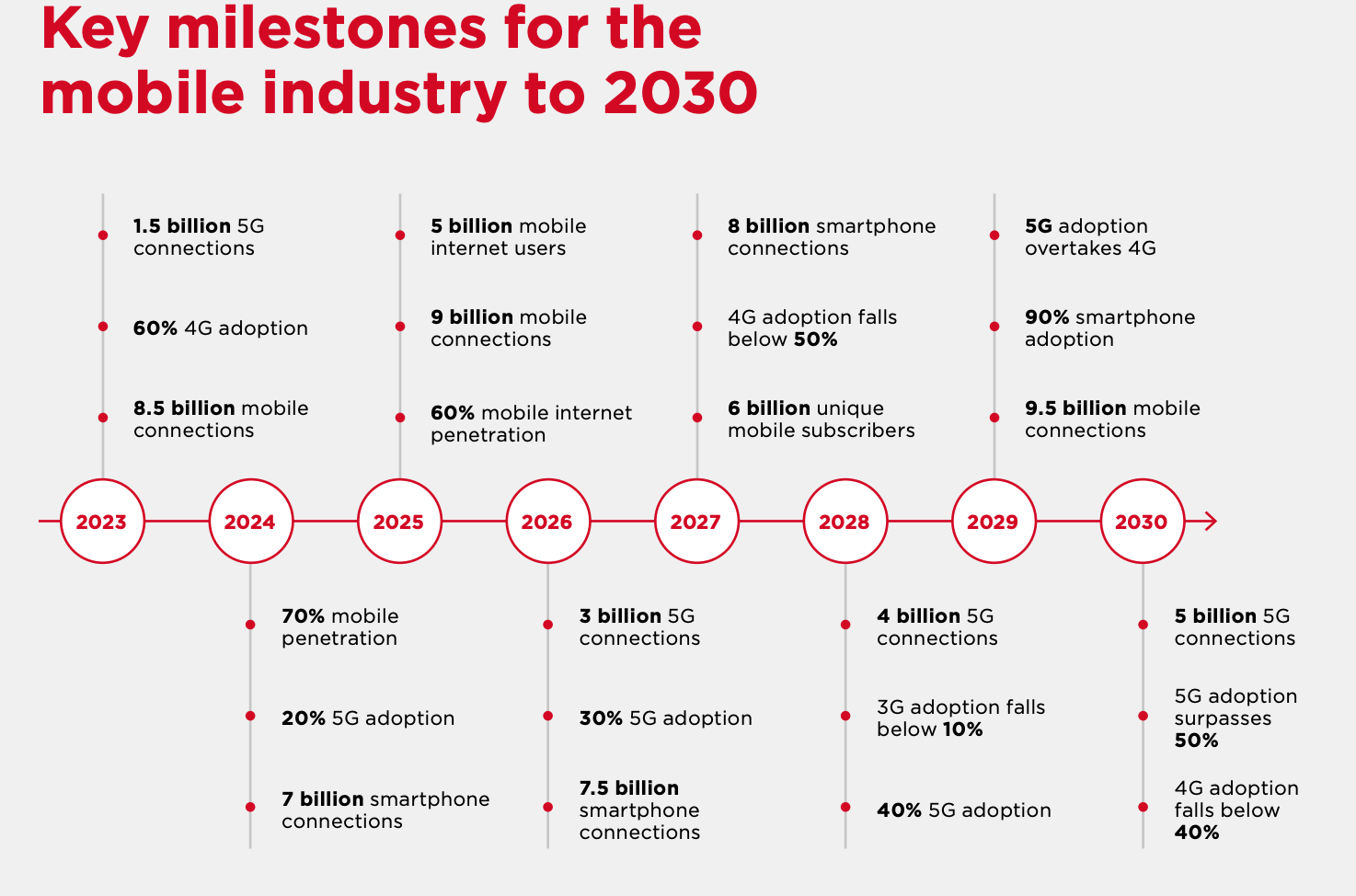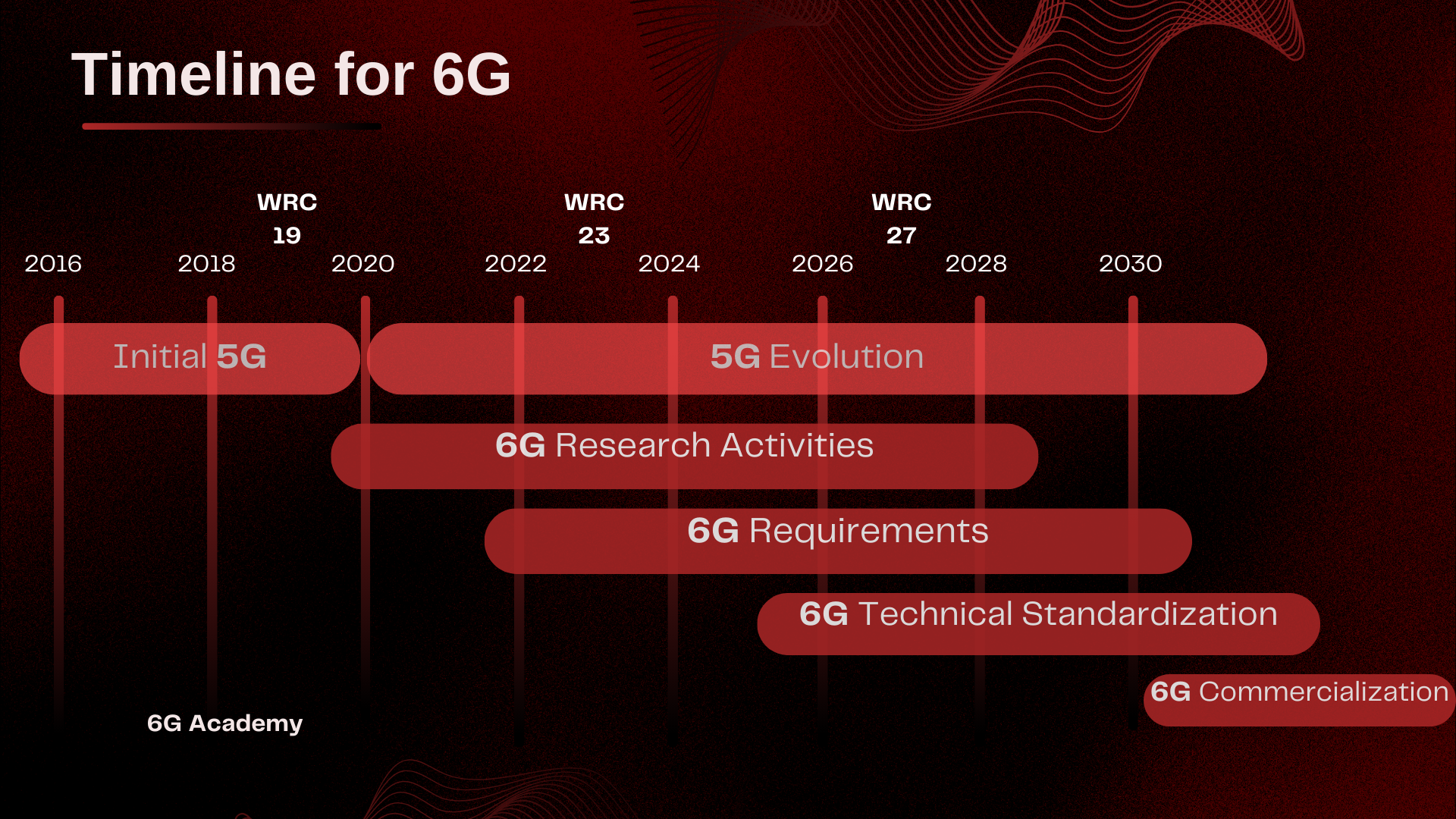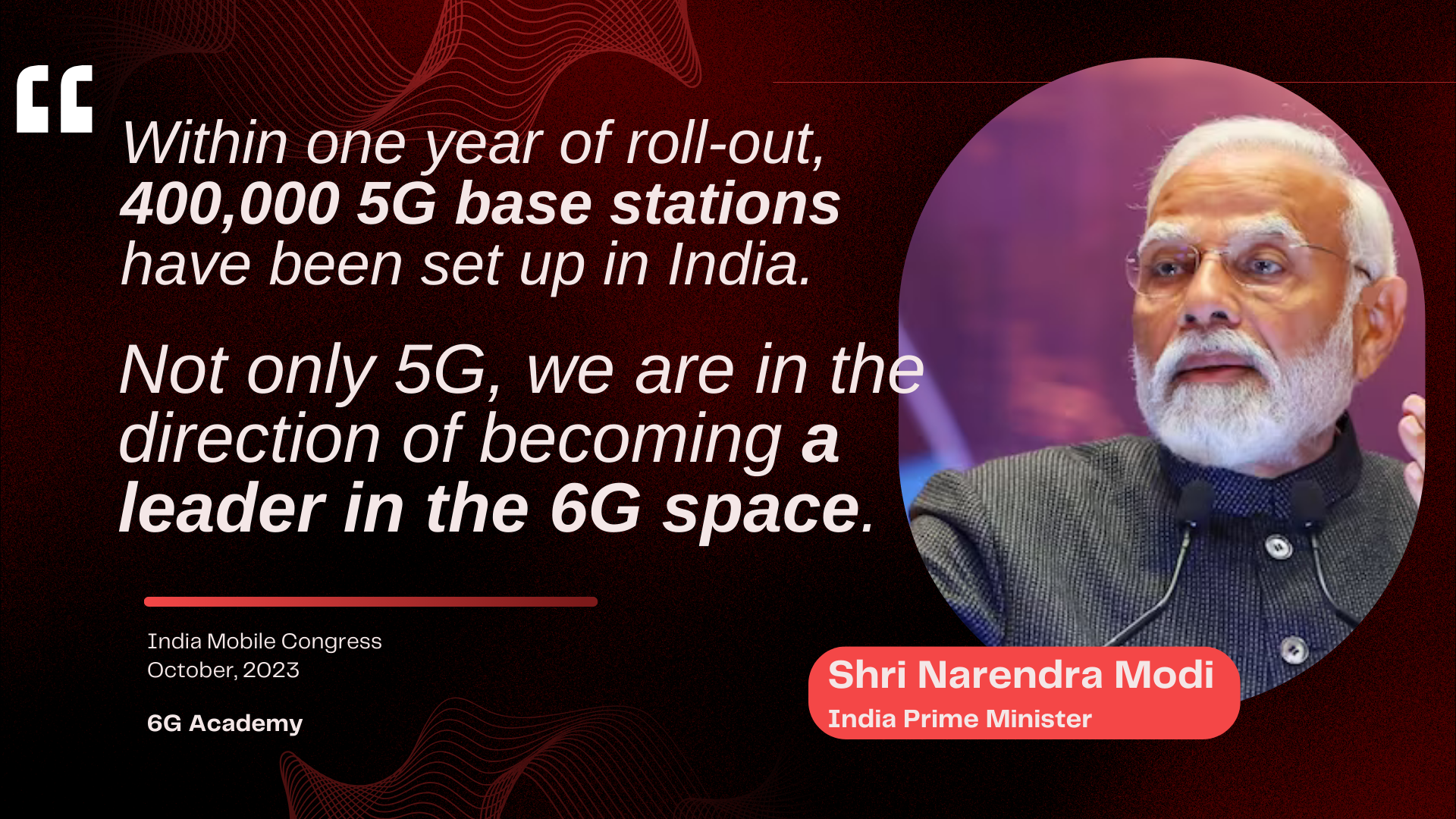
A Glimpse into the Future
Imagine, if you will, a world where the dawn breaks not just with the rising sun but with the boundless possibilities of 6G technology. Envision starting your day not with the jarring blare of an alarm, but with a virtual reality workout session so immersive, that it rivals the tangible sweat and grind of the gym. Your commute is in a self-driving car that isn't just a vehicle but an extension of your living space, perfectly in sync with every digital pulse of your home. And your workday? It unfolds through instantaneous, global collaboration, making geographical borders as obsolete as dial-up internet. This is not the fabric of dreams; this is the imminent reality promised by 6G.

The Journey from 1G to 6G
But before we let our imaginations run wild, let's ground ourselves in the present. We are at a pivotal juncture in the evolution of wireless connectivity. While we navigate the intricate rollout of 5G, wrestling with infrastructural challenges and societal hesitations, the silhouette of 6G begins to loom on the horizon. This moment, ripe with anticipation, demands that we temper our excitement with a critical eye.
Reflecting on the journey from 1G to the present, it's evident that each leap in technology was not just about faster speeds or more connections; it was about redefining what connectivity means to human civilization. With the completion of the first three releases (3GPP Releases 15, 16, and 17) of the 5G standards, we embarked on an ambitious quest to connect virtually everyone and everything around us. The deployment of 5G technologies is unfolding at an unprecedented pace, outstripping all its predecessors in both ambition and scope.
As we stand on the cusp of the 6G era, it's crucial to grasp the magnitude of this evolution. The figure below illustrates a future where 5G is expected to underpin a transformation so profound, it will fuel more than $13.1 trillion in global sales activity by 2035. Yet, as we peer further into the horizon, 6G promises to eclipse even these staggering figures, heralding a new age of technological symbiosis where digital and physical realms merge seamlessly.

In this forthcoming era, our collective imagination is the only boundary. The courses at the 6G Academy are meticulously designed to prepare you for this future. Through tracks like AI-Driven Network Evolution, The Edge Computing Revolution, Secure and Agile Networks, Next-Gen Network Infrastructure, and Consumer-Centric Innovations, we aim to equip you with the knowledge and skills necessary to not only navigate but also shape this new frontier.
As we embark on this journey together, it's vital to remember that the path to 6G is not without its questions and doubts. But it is precisely this blend of skepticism and belief in the indomitable human spirit and intellect that will steer us toward a future where the potential of connectivity is limitless. At the 6G Academy, we're not just preparing for the future; we're actively shaping it. Join us, and let's build the world of tomorrow, today.
The Road to 6G: Navigating the Waves of Innovation
As we chart the course through the evolving landscape of telecommunications, the recent data from the Global mobile Suppliers Association (GSA) offers a panoramic view of 5G's transition from a burgeoning technology to a cornerstone of modern connectivity. The GSA's latest roundup paints a picture of a world deeply entrenched in the era of 5G:
- 582 Operators Investing in 5G Worldwide: A testament to the global commitment to advancing the network infrastructure.
- 294 Commercial 5G Launches: Signifying a robust and growing ecosystem.
- 2,700+ 5G Devices Announced: Illustrating the explosive innovation in 5G hardware.
- At Least 1,886 Commercial 5G Devices Available: Highlighting the rapid market adaptation.
- More Than $50 Billion Spent on 5G-Related Spectrum Auctions and Assignments: Underlining the significant financial investment in the future of connectivity.
- 255 Vendors Producing or Planning 5G Devices: Demonstrating the widespread industrial engagement in 5G technology.

The progression from 1G to 6G represents not just a series of technological advancements but a transformative journey that has redefined the fabric of society. Each leap forward has been accompanied by its unique challenges and learnings, propelling us towards greater heights of innovation. The path to 6G, laden with both promise and complexity, beckons us to not only celebrate our achievements but also to scrutinize the path that lies ahead with a critical eye.

Mapping the Future: The Standardization and Global Momentum of 6G
The blueprint for the future of telecommunications is being meticulously drafted, with the 3rd Generation Partnership Project (3GPP) at its core. This global consortium is the crucible where each new generation of mobile technology is forged, setting the standards that pave the way for global connectivity and innovation. As we turn our gaze towards the horizon, the timeline for 6G standardization begins to take shape, promising a new chapter in the saga of mobile communication.
The Timeline for 6G Standardization
According to current projections, the formal work on 6G standards is slated to commence around 2025. This initial phase will delve into the exploration of potential use cases and foundational technologies, such as advanced waveforms, channel coding, and the integration of Artificial Intelligence (AI), sensing capabilities, and comprehensive strategies for architectural evolution and migration. This period of study and analysis is critical, laying the groundwork for what will eventually become the first set of 6G specifications.

As we edge closer to realizing the vision of 6G, the earliest work items will catalyze the development of these specifications, setting the stage for commercial launches anticipated to begin in 2030— a decade following the advent of 5G. To meet this ambitious timeline, the inaugural 6G standard must be finalized and ratified by early 2028, ensuring that trials and interoperability testing are completed in time for a seamless commercial rollout.
The Global Drive Towards 6G Innovation
Even though the formal development and commercialization of 6G remain on the distant horizon, the groundwork is already being laid through a myriad of regional initiatives across the globe. In North America, the Next G Alliance is spearheading efforts to position the region as a leader in 6G technology. Europe's response comes in the form of Hexa-X, while Asia is not far behind, with several initiatives pushing the boundaries of what's possible with 6G.
United States: The National Science Foundation (NSF) has awarded over $53 million for 6G research, with a significant portion of the funding directed to universities across different states. Additionally, the Biden-Harris Administration has awarded nearly $5.5 million in grants from the Wireless Innovation Fund to support the development of open and interoperable wireless networks, with contributions towards 5G and 6G networks. This figure is expected to rise to $179 million in 2024, highlighting the growing emphasis on developing technologies that will underpin future communications networks.
India has launched the Bharat 6G Alliance (B6GA) with significant government funding to foster the development of 6G technology. The government has allocated a grant of Rs. 240.5 crores under the Telecom Technology Development Fund (TTDF) for 6G-related projects, alongside an additional Rs. 48 crore to support 66 startups and MSMEs under the Digital Communication Innovation Square (DCIS). These initiatives aim to position India as a leader in 6G technology and innovation on the global stage.

China
China has initiated substantial efforts towards 6G research and development, demonstrating a clear strategic focus on establishing leadership in future telecommunications technologies. This initiative is part of a broader ambition to not only continue the success seen with 5G but to also position China at the forefront of the next technological frontier in mobile communications.
A notable development in this endeavor is the establishment of a national 6G technology research and development group, comprising government ministries, research institutes, and enterprises. This collaboration underscores the comprehensive approach China is taking, integrating resources from across sectors to drive innovation in 6G technology. The group's formation was reported as a significant move to kickstart 6G research, emphasizing the country's commitment to leading the next wave of wireless innovation.
Further highlighting China's proactive stance in the 6G domain, Huawei, a leading Chinese telecommunications company, announced its commencement of work on 6G technology as early as 2019. This early start, coupled with substantial investments in research and development—USD 22.1 billion in 2021 alone—positions Huawei and by extension, China, as key players in shaping the future of 6G technology. Huawei's efforts are complemented by collaborations with other major Chinese and international entities, including ZTE, Nokia, and Ericsson, as well as state-owned telecom companies like China Unicom and China Mobile.
China's focus on 6G is not limited to telecommunications alone; the country has also achieved several "6G firsts," such as launching the "world’s first 6G satellite" in 2020, indicating a broader scope of application and experimentation within the 6G technology spectrum. These achievements underscore China's intent to explore and expand the boundaries of wireless communication, positioning itself as a leader in this emerging field.
Despite these advancements, the exact details regarding the funding amount and specific allocations within China's 6G research initiatives remain unclear. However, the collaborative effort involving government, academia, and industry, along with China's significant patent filings in 6G technology—accounting for 40.3% of global 6G patent filings—reflects a comprehensive and strategic approach to securing a leading position in the next generation of telecommunications technology.
China's efforts in 6G research and development, supported by substantial investments and strategic collaborations, highlight its ambition to not only contribute to but also lead the global discourse on future telecommunications standards and technologies.
UK
£110 Million Telecom R&D Package: The UK government announced a £110 million investment package aimed at accelerating research on 5G and 6G technologies. As part of this initiative, three leading UK universities—the University of York, the University of Bristol, and the University of Surrey—were awarded a share of £28 million. This funding is intended to support these institutions in collaborating with major telecoms companies like Nokia, Ericsson, and Samsung to develop next-generation network technology, including 6G. An additional £80 million was allocated to establish a state-of-the-art UK Telecoms Lab in the West Midlands, focusing on testing network equipment and enhancing network technology security, resilience, and performance.
UKRI National 6G Radio Systems Facility at the University of Sheffield: The University of Sheffield announced the establishment of the UKRI National 6G Radio Systems Facility, funded by the Engineering and Physical Sciences Research Council (EPSRC). This facility aims to position the UK as a global leader in 6G technology by creating a vibrant research community, bringing together academics and industry partners with the necessary specialist equipment to innovate and support the delivery of future 6G services.
Open Networks Ecosystem (ONE) Competition: Over £6.6 million was awarded to three projects that promise to benefit future 6G networks. These projects, part of the ONE Competition, aim to demonstrate the reliability and feasibility of Open Radio Access Network (RAN) technologies and cover various research topics from components to energy efficiency and networks. Though not exclusively 6G-focused, the outcomes of these projects are expected to contribute significantly to the development of future mobile internet generations.
Germany
Germany is actively investing in and leading several significant 6G research initiatives, demonstrating its commitment to advancing the next generation of mobile communications technology and ensuring its technological sovereignty. Here's a summary of key projects and funding details:
- 6G-ANNA Project: This project, coordinated by Nokia, brings together 34 partners from industry and academia, including notable names like Airbus, Ericsson, Siemens, and Vodafone. With a focus on establishing wide-ranging expertise in future mobile communications, the German federal government has dedicated €38.4 million to 6G-ANNA. The project aims to influence the standardization of 6G early on, highlighting the strategic importance of early involvement in global standards development.
- 6G-life Research Hub: A major joint project between Technische Universität Dresden and Technical University Munich, "6G Life" is funded with €70 million by the German Federal Ministry of Education and Research (BMBF). The project employs around 120 staff members and focuses on scalable communication, innovative concepts, and technical challenges pivotal for 6G development, with implications for Industry 4.0 and healthcare.
- 6G Research Hubs Funding: The BMBF is allocating up to €250 million to establish four hubs for 6G research, including the 6G Research and Innovation Cluster (6G-RIC) and the Open6GHub, both involving Fraunhofer FOKUS. These hubs are tasked with designing components for a distributed 6G core network and integrating them into test environments, aiming for a holistic 6G system that addresses the highest standards of reliability and flexibility.
- Deutsche Telekom's 6G-TakeOff Project: This project is part of a broader program for research into integrated systems and sub-technologies for 6th generation mobile communications, focusing on developing a uniform 6G architecture. With a consortium of 22 partners, the project explores network orchestration across satellites, flying platforms, and ground networks, aiming to improve network resilience and security using artificial intelligence (AI).
- Overall Investment in 6G R&D: Germany has committed a total of €700 million into 6G research and development. This investment supports the creation of research hubs and a platform for future communication technologies and 6G, coordinating activities and international cooperation on regulation and standardization issues. This massive investment underscores Germany's intention to maintain and enhance its position in the digital and technological landscape, promoting intellectual property ownership and avoiding dependence on international tech giants.
Germany's strategic investments and collaborative projects in 6G research highlight its ambition to lead in the development and standardization of the next generation of mobile communications. By fostering a robust ecosystem of academic and industrial partners, Germany aims to secure its technological sovereignty and play a decisive role in shaping the future digital infrastructure.
Finland
- 6G Flagship Program at the University of Oulu: This program, initiated in 2018, is a beacon of 6G research globally, focusing on the development of 6G standards, exploring wireless technology, and supporting the industry in commercializing 5G. The Finnish government and EU have backed this initiative with significant funding, including a €9.56 million grant over three years, with the total Horizon Europe funding for all partners involved in the 12 projects amounting to €102 million.
- 6G Bridge Program: Managed by Business Finland, this program aims to maintain Finland's leadership in connectivity and provide growth opportunities for Finnish companies. It runs from January 2023 until the end of 2026, with a planned budget of €130 million for innovation funding. Another initiative, also named 6G Bridge, has a planned budget of €150 million running until the end of 2028, focusing on innovation funding within the 6G domain.
- World’s First Experimental 6G Research Environment: Finland is building the "6G-FUWIRI" research infrastructure, funded by the Academy of Finland. This project elevates radio technology research to very high sub-THz frequencies and marks a significant step in the development of a 6G research environment in Finland.
- Collaboration with South Korea: The University of Oulu and the Electronics and Telecommunications Research Institute (ETRI) in South Korea have embarked on a collaborative project to develop an advanced system architecture for 6G systems, part of the broader 6G Bridge program.
- Ericsson and Government of Canada Partnership: Ericsson, in collaboration with the Government of Canada, is investing more than CAD 470 million in R&D centers in Ottawa, Ontario, and Montreal, Quebec. This investment aims to advance 5G Advanced, 6G, AI, Cloud RAN, and Core Network technologies, creating and upskilling hundreds of jobs over the next five years.
- Key Stakeholders: The main stakeholders in Finland's 6G research include the University of Oulu, Business Finland, the Academy of Finland, various Finnish universities and research institutes, and global partners like the Electronics and Telecommunications Research Institute (ETRI) in South Korea and companies such as Nokia leading European 6G flagship projects Hexa-X and Hexa-X-II.
Finland's comprehensive approach to 6G research, characterized by robust funding, international collaboration, and pioneering projects, positions the country as a global leader in shaping the future of telecommunications.
European Union: The EU has allocated €130 million to a variety of 6G projects under Horizon Europe, focusing on system architecture, wireless communication technologies, infrastructure technologies, and more.
France: The French government has issued a call for €750 million for R&D projects on advanced 5G and future network generations, as part of Macron’s France 2030 investment plan.
South Korea: The Korean government has launched a feasibility study for 6G technology research with a budget of KRW 625.3 billion ($481.7 million), aiming to commercialize initial 6G network services by 2028.
Australia: Information on specific funded 6G projects in Australia was not directly available from the sources reviewed. However, Australia is actively participating in global 6G research efforts and discussions, focusing on areas like telecommunications policy, technology standards, and innovation in wireless technologies.
These regional endeavors are more than just preparatory steps; they are the vanguard of a global movement towards next-generation technologies. By fostering early discussions and research into 6G, these initiatives are essential in shaping the future narrative of telecommunications, ensuring that the transition from vision to reality is as smooth as it is revolutionary. Annual events like the Brooklyn 6G Summit, 6G Symposium, EuCNC 6G Summit, and the 6G@UT Forum have become crucibles of innovation, where academic and industry leaders converge to share insights and developments that will eventually feed into the global standardization efforts for 6G.
Envisioning the Future: The Capabilities and Design Targets of 6G
As we stand on the threshold of a new era in telecommunications, the vision for 6G begins to crystallize, promising not just an evolution but a revolution in connectivity and technology. 6G is poised to redefine the landscape of digital communication, integrating a myriad of foundational wireless and adjacent technologies. This integration is not merely an upgrade but a complete reimagining of what is possible, setting ambitious design targets and system capabilities that will underpin the next generation of connectivity.
The Pillars of 6G Innovation
Connectivity: At its core, 6G aims to extend the reach of wireless communication, connecting an even greater number of people and devices. This next-generation network will transcend traditional boundaries between fixed and mobile communication, offering unprecedented voice and data capabilities. The promise of 6G is to revolutionize our approach to connectivity, making it more inclusive and accessible, thereby transforming the way we live, work, and interact.
AI-Native Networks: Inherently designed with artificial intelligence from the outset, these networks will utilize AI not just for ancillary tasks but as a core driver of their operation, optimization, and service delivery. This deep integration of AI enables real-time, autonomous decision-making across the network, leading to unparalleled efficiencies, self-healing capabilities, and personalized user experiences. By leveraging continuous, end-to-end information collection, AI-Native Networks promise to dynamically orchestrate and optimize network resources, ensuring optimal performance and paving the way for innovative services and applications.
The Edge Computing Revolution: This paradigm shift aims to drastically reduce latency, enhance data privacy, and lessen the reliance on centralized cloud infrastructures. By distributing computing power and storage capabilities to the edge of the network, edge computing enables immediate data processing and analysis, facilitating real-time applications and services critical for the next generation of IoT, smart cities, and immersive technologies. This approach not only streamlines network operations but also opens the door to a new realm of possibilities in how we interact with and manage digital ecosystems.
Secure and Agile Networks: Flexibility and resilience are at the heart of 6G's architecture, designed to support a wider array of devices and applications. Building upon the security foundations of 5G, 6G will reimagine security, data management, and privacy. Innovations in multifaceted trust, configurable security, and post-quantum cryptography are set to redefine the standards of network security and reliability, ensuring that 6G networks are both robust and adaptable.
Integrated Sensing: 6G will significantly enhance the precision of cellular-based positioning, introducing it into new devices and services. The integration of communications and sensing, along with sensor fusion across RF and non-RF sensors, will open up a plethora of new use cases. From localization and gesture recognition to imaging and environmental detection, 6G is set to offer unprecedented insights and value.
Green Network: Sustainability is a cornerstone of 6G's design philosophy. From its inception, 6G is being envisioned with energy efficiency and environmental impact in mind. The potential for energy-harvesting technologies to power devices and applications without the need for batteries is a testament to 6G's commitment to a sustainable future.
Preparing for the 6G Horizon
The journey towards 6G is more than a technological evolution; it is a strategic imperative for all stakeholders in the digital ecosystem. As we navigate this transition, the importance of readiness through research, development, and education cannot be overstated.
Business Readiness: For the corporate world, the preparation for 6G is twofold. Firstly, it involves direct investment in research and development initiatives that align with 6G's capabilities, such as AI-driven solutions and edge computing applications. Secondly, it requires nurturing a culture of innovation and agility within organizations, enabling them to adapt quickly to the changes and opportunities 6G will bring.
Moreover, building skills-based organizations through comprehensive upskilling and reskilling initiatives is essential. This approach ensures that the workforce is equipped with the latest technological competencies and can thrive in a rapidly evolving digital landscape, thereby maximizing the transformative potential of 6G.
->Partner with the 6G Academy to drive innovation and secure a competitive edge in the forthcoming 6G landscape.
Governmental Role: Governments have a critical role in supporting the transition to 6G. This includes not only the allocation of resources and spectrum for 6G development but also the implementation of policies that encourage innovation and protect the interests of consumers and businesses alike. Moreover, investing in educational initiatives and public-private partnerships will be vital for cultivating a skilled workforce ready to thrive in a 6G-powered economy.
Collaborate with the 6G Academy to lay the policy and educational foundation for a thriving 6G future.
Individual Empowerment: On an individual level, preparing for 6G means becoming an active participant in the emerging digital landscape. This involves pursuing lifelong learning in cutting-edge technologies, understanding the implications of 6G for privacy and security, and engaging with digital platforms to adapt to new ways of communicating and conducting business.
->>Embark on your learning journey with the 6G Academy and become an architect of the digital future.
As we look towards a future powered by 6G, the collective efforts of businesses, governments, and individuals will be paramount in realizing its full potential. By investing in the pillars of research, development, and education today, we lay the groundwork for a future that is not only connected by 6G but transformed by it.
Author
Piotr (Peter) Pietrzyk - CEO & Founder, 6G Academy | 6G Portal | 6G Jobs










